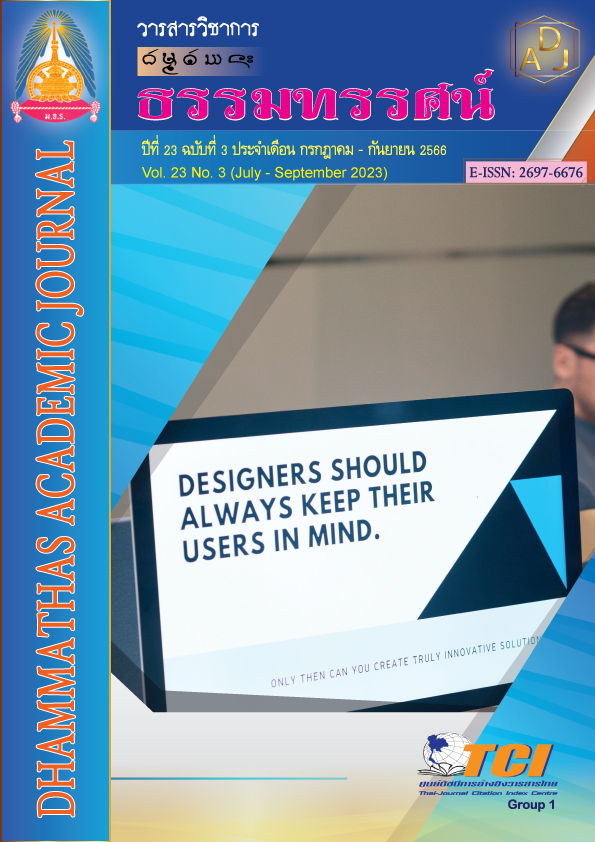Study of Academic Achievement and Opinions of Students in Mathayom Suksa 5, Thammasat Klongluang Wittayakom School After Organizing Learning using Multimedia Technology together with Teaching in the Vertual School System, Lilit Taleng Phai
Main Article Content
Abstract
The purposes of this research were; 1) Comparing the academic performance of Thai language before and after incorporating multimedia technology in virtual school system, 2) Studying satisfaction with the teaching outcomes using multimedia technology in virtual school system. The population were grade 5. The sample group consists of students from class 5/1, totaling 45 people, selected through simple random sampling. The research instrument were 1) Learning management plan Study Unit , 4 Lesson plans on Lilit Taleng Pai 2) Thai Language Achievement Test 30 items 3) Satisfaction questionnaire 15 items. The statistics used for data analysis were percentage, mean, standard deviation and T-Test (t-test for dependent).
The research result finds that:
1. The academic performance in Thai language before and after learning has shown that the students' performance after learning is significantly higher than before learning at a statistically significant level of .01.
2. The satisfaction with teaching outcomes using multimedia technology in the Virtual School system among 5th-grade students at Thammasat Khlong Luang Wittayakom School is generally high. When considering different aspects individually, the highest level of satisfaction is found in the area of learning activities. It is followed by teacher instruction and content, respectively.
Article Details

This work is licensed under a Creative Commons Attribution-NonCommercial-NoDerivatives 4.0 International License.
เพื่อให้เป็นไปตามกฎหมายลิขสิทธิ์ ผู้นิพนธ์ทุกท่านต้องลงลายมือชื่อในแบบฟอร์มใบมอบลิขสิทธิ์บทความ ให้แก่วารสารฯ พร้อมกับบทความต้นฉบับที่ได้แก้ไขครั้งสุดท้าย นอกจากนี้ ผู้นิพนธ์ทุกท่านต้องยืนยันว่าบทความ ต้นฉบับที่ส่งมาตีพิมพ์นั้น ได้ส่งมาตีพิมพ์เฉพาะในวารสาร วิชาการธรรม ทรรศน์ เพียงแห่งเดียวเท่านั้น หากมีการใช้ ภาพหรือตารางของผู้นิพนธ์อื่นที่ปรากฏในสิ่งตีพิมพ์อื่นมาแล้ว ผู้นิพนธ์ต้องขออนุญาตเจ้าของลิขสิทธิ์ก่อน พร้อมทั้ง แสดงหนังสือที่ได้รับการยินยอมต่อบรรณาธิการ ก่อนที่บทความจะได้รับการตีพิมพ์References
ชูศรี วงศ์รัตนะ และองอาจ นัยพัฒน์. (2551). แบบแผนการวิจัยเชิงทดลองและสถิติวิเคราะห์: แนวคิดพื้นฐานและวิธีการ. กรุงเทพฯ: จุฬาลงกรณ์มหาวิทยาลัย.
ธเนศ อินเมฆ และต้องตา สมใจเพ็ง. (2560). แนวทางการจัดกิจกรรมการเรียนรู้โดยการใช้สื่อประสม เรื่อง การบวกและการลบจำนวนเต็ม. วารสารศึกษาศาสตร์ปริทัศน์, 32(2), 121-128.
ธิดารัตน์ คล้ายอักษร และธนัชยศ จำปาหวาย. (2562). การแก้ปัญหาผลสัมฤทธิ์ทางการเรียน เรื่อง พื้นที่ผิวของปริซึมโดยใช้สื่อประสม สำหรับนักเรียนชั้นมัธยมศึกษาปีที่ 3/4 โรงเรียนมัธยมวัดดุสิตาราม. วารสารวิชาการ ครุศาสตร์สวนสุนันทา, 3(2), 11-19.
บริษัท บางกอกซอฟแวร์ จำกัด. (2560). Virtual School Education Platform. เข้าถึงได้จาก https://www.bkk-software.co.th/virtualschool.html
บุญชม ศรีสะอาด. (2560). การวิจัยเบื้องต้น. (พิมพ์ครั้งที่ 10). กรุงเทพฯ: สุวีริยาสาสน์.
พิชิต ฤทธิ์จรูญ. (2552). หลักการวัดและประเมินผลการศึกษา. (พิมพ์ครั้งที่ 6). กรุงเทพฯ: เฮ้าส์ ออฟ เคอร์มีสท์.
พิชิต ฤทธิ์จรูญ. (2559). เทคนิคการวิจัยเพื่อพัฒนาการเรียนรู้. กรุงเทพฯ: จุฬาลงกรณ์มหาวิทยาลัย.
รุ่งอรุณ พรเจริญ. (2558). การพัฒนาชุดสื่อประสมสำหรับการสอนการสื่อสารทางแสงเพื่อพัฒนาทักษะทางปัญญา ตามกรอบมาตรฐานคุณวุฒิระดับอุดมศึกษา. วารสารวิชาการและวิจัย มหาวิทยาลัยเทคโนโลยีราชมงคลพระนคร, 9(2), 142-150.
วัลลภ ใหญ่เลิศ. (2556). การพัฒนาสื่อประสมทักษะการคิดวิเคราะห์วิชาภาษาอังกฤษ โดยการเรียนแบบแบ่งกลุ่มสัมฤทธิ์สำหรับนักเรียนชั้นประถมศึกษาปีที่ 6. (วิทยานิพนธ์ศึกษาศาสตรมหาบัณฑิต). บุรีรัมย์: มหาวิทยาลัยราชภัฏบุรีรัมย์.
สำนักงานคณะกรรมการพัฒนาการเศรษฐกิจและสังคมแห่งชาติ. (2559). แผนพัฒนาเศรษฐกิจและสังคมแห่งชาติ ฉบับที่ 12 พ.ศ. 2560-2564. กรุงเทพฯ: สำนักนายกรัฐมนตรี.
สำนักงานเลขาธิการสภาการศึกษา. (2560). แผนการศึกษาแห่งชาติ พ.ศ. 2560-2579. กรุงเทพฯ: พริกหวานกราฟฟิค.
Dastbaz, M. (2002). Designing interactive multimedia systems. London: printed text.

